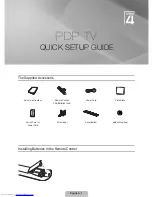
Automatic Colour Limiting (ACL) circuit which is switchable via the I 2 C-bus and which prevents
that oversaturation occurs when signals with a high chroma-to-burst ratio are received. The ACL circuit
is designed such that it only reduces the chroma signal and not the burst signal. This has the advantage
that the colour sensitivity is not affected by this function. The SECAM decoder contains an auto-
calibrating PLL demodulator which has two references, viz: the divided 12 MHz reference frequency
of the crystal oscillator which is used to tune the PLL to the desired free-running frequency and the
bandgap reference to obtain the correct absolute value of the output signal. The VCO of the PLL is
calibrated during each vertical blanking period, when the IC is in search or SECAM mode. The
reference frequency of the colour decoder is fed to the Fsc output (pin 49) and can be used to tune an
external comb filter. The base-band delay line is integrated. The demodulated colour difference signals
are internally supplied to the delay line. The colour difference matrix switches automatically between
PAL/SECAM and NTSC, however, it is also possible to fix the matrix in the PAL standard.
2.7.
PICTURE IMPROVEMENT FEATURES
In the TDA 8885 series various picture improvement features have been integrated. These features are:
-Video dependent coring in the peaking circuit. The coring can be activated only in the low-light parts
of the screen. This effectively reduces noise while having maximum peaking in the bright parts of the
picture.
-Colour Transient Improvement (CTI). This circuit improves the rise and fall times of the colour
difference signals. The function is realised by using delay cells with a length of 300 ns.
-Black-stretch. This circuit corrects the black level for incoming video signals, which have a deviation
between the black level and the blanking, level (back porch). The time constant for the black stretcher
is realised internally
-Blue-stretch. This circuit is intended to shift colour near ‘white’ with sufficient contrast values
towards more blue to obtain a brighter impression of the picture
-White-stretch. This function adapts the transfer characteristic of the luminance amplifier in a non-
linear way dependent on the picture content. The system operates such that maximum stretching is
obtained when signals with a low video level are received. For bright pictures the stretching is not
active.
-Dynamic skin tone (flesh) control. This function is realised in the YUV domain by detecting the
colourss near to the skin tone. The correction angle can be controlled via the I
2
C-bus.
2.8.
RGB output circuit and black-current stabilisation
The ICs have a very flexible control circuit for RGB and YUV input signals, which has the following
features:
· Input which can be used for YUV or RGB input signals and as YUV interface. The selection of the
various modes can be realised via the I
2
C-bus. For the YUV input 2 different input signal conditions
can be chosen. It is also possible to connect the synchronisation circuit to the incoming Y input signal.
This input signal can be controlled on saturation, contrast and brightness.
· The RGB-1 input which is intended for OSD/text signals and which can be controlled on contrast and
brightness. By means of the IE1 bit the insertion blanking can be switched on or off. Via the IN1 bit it
can be read whether the insertion pin has a high level or not. It is also possible to convert the incoming
RGB-1 signal to a YUV signal. The resulting signal is supplied to the YUV outputs.
· The TDA 888X versions have an additional YUV or RGB input which can be controlled on contrast,
saturation and brightness. The various input signal conditions are given. The insertion blanking of this
input can be switched-off by means of the IE2 bit. Via the IN2 bit it can be read whether the insertion
pin has a high level or not. The control circuit has a half tone input, which can be used to reduce the
contrast setting during mixed mode operation for teletext and OSD signals. The output signal has
amplitude of about 2 V black-to-white at nominal input signals and nominal settings of the controls. To
increase the flexibility of the IC it is possible to insert OSD and/or teletext signals directly at the RGB
outputs. This insertion mode is controlled via the insertion input (pin 38). This blanking action at the
RGB outputs has some delay, which must be compensated externally.
To obtain an accurate biasing of the picture tube the ‘Continuous Cathode Calibration’ system has been
included in this IC. Via the I
2
C-bus a black level offset can be made with respect to the level which is
generated by the black current stabilisation system. In this way different colour temperatures can be
obtained for the bright and the dark part of the picture.
Содержание CT-W3250S-1
Страница 1: ...SERVICE MANUAL CTW3250S 1 76CM WS CTV CHASSIS 11AK33 SEP02 CTW3250S 1 ...
Страница 2: ...11 AK 33 Service Manual ...
Страница 46: ......
Страница 47: ......
Страница 48: ......
Страница 49: ......
Страница 50: ......
Страница 51: ......
Страница 52: ......
Страница 53: ......
Страница 54: ......









































